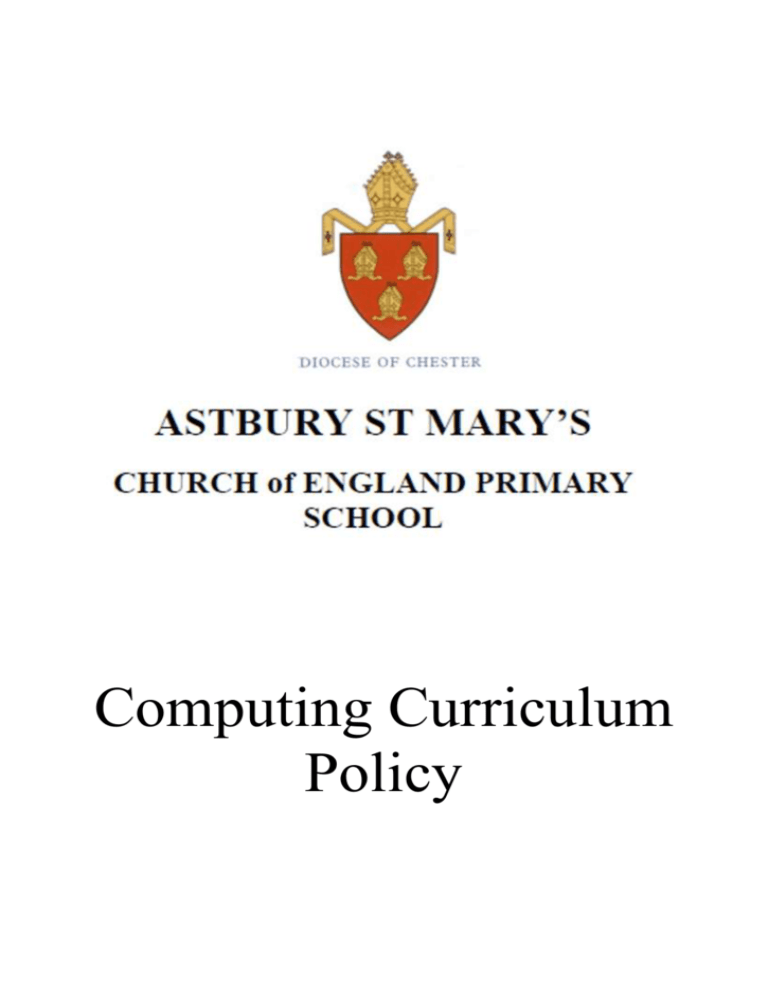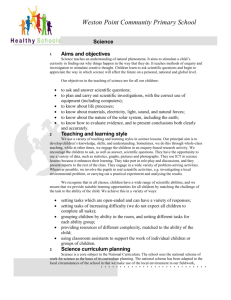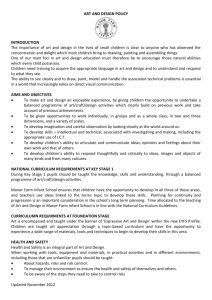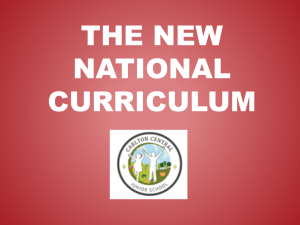Computing Policy Astbury May 2015
advertisement

Computing Curriculum Policy Aims and objectives 1.1 High quality computing education equips pupils to use computational thinking and creativity to understand and change the world. Computing has deep links with mathematics, science and design and technology, and provides insights into both natural and artificial systems. The core computing is computing science, in which pupils are taught the principles of information and computation, how digital systems work, and how to put this knowledge to use through programming. Building on this knowledge and understanding, pupils will be equipped to use information technology to create programs, systems and a range of content. Computing also ensures that pupils become digitally literate- able to use and express themselves and develop their ideas through, information and communication technology- at a level for the future workplace and as active participants in a digital world, 1.2 Our objectives in the teaching of science are for all our children: to know how to understand and apply concepts of computer science, including abstraction, logic, algorithms and data representation. to know how to analyse problems and have practical experience of wiring computer programs in order to solve problems. to evaluate and apply information technology by using familiar and unfamiliar technologies. to learn to be responsible users of information and communication technology. To learn how to be creative users of information and communication technology 2 Teaching and learning style 2.1 We encourage the children to engage in a wide variety of problem-solving activities. Wherever possible, we involve the pupils in real computing activities relevant to everyday life. E.g. live web chats, blogging, online problem solving, writing and fixing their own programs. We use a variety of teaching and learning styles in computing lessons. Our principal aim is to develop children's knowledge, skills, and understanding. Sometimes, we do this through whole-class teaching, while at other times, we engage the children in practical activities where they learn through discovery. 2.2 We recognise that in all classes, children have a wide range of computing abilities, and we ensure that we provide suitable learning opportunities for all children by matching the challenge of the task to the ability of the child. We achieve this in a variety of ways: setting tasks which are open-ended and can have a variety of responses; setting tasks of increasing difficulty (we do not expect all children to complete all tasks); sometimes grouping children by ability in the room and sometimes in mixed ability, and setting different tasks for each ability group; providing resources of different complexity, matched to the ability of the child; using classroom assistants to support the work of individual children or groups of children. 3 Computing curriculum planning 3.1 Computing must be taught at key stage 1 and key stage 2. Pupils should have been taught subject content as outlined by the National Curriculum 2014 by the end of the key stages. Teachers are expected to use information and communication technology skills making them digital literate through the teaching of core subjects, Maths, English and Science. This can be in as many lessons the teacher seems suitable. As a school it is expected a minimum of three times a week. Computing is also taught through discrete computing lessons devised into computer science, digital literacy and information technology. As technology and the resources available for teaching computing are something which constantly change, this means the planning and ideas for the teaching of computing may also change. The scheme of work has been adapted to the circumstances of the school in the form of a bespoke curriculum that has been designed to ensure full coverage for all our children. 3.2 The long-term plans cover year groups and key stages. As we have some mixed-age classes, we do our long term planning on a two-year rotation cycle. In this way, we ensure complete coverage of a broad Curriculum, without repeating topics. 3.3 The class teacher is responsible for writing the lesson plans for each lesson. These plans list the specific learning objectives and of each lesson. The class teacher keeps these individual plans and the record of achievement. They and the Computing subject leader discuss them on a regular basis. 3.4 We have planned the topics in computing so that they build on prior learning. We ensure that there are opportunities for children of all abilities to develop their skills and knowledge in each lesson, and we also build progression into the computing scheme of work, revisiting a variety of topics as the children move up the school. This consolidates and builds on previous learning and challenging the children to investigate the theme to an ever increasing depth through investigations and research based activities. 4 The Early Years Foundation Stage (EYFS) 4.1 We teach technology in reception classes as an integral part of the topic work covered during the year. As the reception class is part of the EYFS of the National Curriculum, we relate the computing aspects of the children's work to the objectives set out in the Early Years Foundation Stage Targets covered under Technology, this underpins the curriculum planning for children aged three to five. 5 The contribution of computing to teaching in other curriculum areas 5.1 English Computing contributes significantly to the teaching of English in our school by actively promoting the skills of reading, writing, speaking and listening. This is developed through Digital Literacy when they become able to use and express themselves by developing their ideas through information and communication technology. 5.2 Mathematics and Science Computing contributes to the teaching of mathematics and science in several ways. By encouraging children to develop their computer science skills using algorithms, logic, and data to represent information and ideas. By practically developing inventiveness and resourcefulness in applying theories and using known real world systems to solve problems. 5.3 Personal, social and health education (PSHE) and citizenship Computing makes a significant contribution to the teaching of PSHE and citizenship. This is mainly in two areas. Firstly, the subject matter lends itself to raising matters of citizenship and social welfare. For example, children learn how to be responsible for social media they read and create. Secondly, the subject gives children numerous opportunities to debate and discuss through problem solving. 5.4 Spiritual, moral, social and cultural development As a Church school we follow the national curriculum but are aware that some topics may raise discussions about faith. As a result we follow the Diocese guidance on teaching these subjects. 6 Computing and inclusion 6.1 At our school, we teach computing to all children, whatever their ability and individual needs. Computing forms part of the school curriculum policy to provide a broad and balanced education to all children. Through our computing teaching, we provide learning opportunities that enable all pupils to make good progress. 6.2 When progress falls significantly outside the expected range, the child may have special educational needs. Our assessment process looks at a range of factors – classroom organisation, teaching materials, teaching style, and differentiation – so that we can take some additional or different action to enable the child to learn more effectively. Assessment against the curriculum objectives allows us to consider each child's attainment and progress against expected levels. This ensures that our teaching is matched to the child's needs. 7 Assessment for learning 7.1 Teachers assess children's work in computing by making formal judgements during lessons, if the child has achieved the objective set for that lesson. On completion of a piece of work, the teacher assesses it, and uses this assessment to plan for future learning. Written or verbal feedback is given to the child to help guide his/her progress. Older children are questioned about their ideas and encouraged to make judgements about how they can improve their own work and extend their learning. 7.2 At the end of a unit of work, the teacher makes a summary judgement about the work of each pupil in relation to the curriculum objectives and learning outcomes. The teacher records progress on an excel document which relates to the topic assessment sheets for each learning unit. Attainment and progress will be rated as Emerging, Expected and Exceeded and be noted in the correct box on the spreadsheet. We use this as the basis for assessing the progress of each child, and we pass this information on to the next teacher at the end of the year. 7.3 Teachers make an assessment of the children's work in computing annually based on data collected throughout the year. 8 Resources 8.1 We have desktop computers and laptop computers available in every classroom for a group of children to work on in every lesson (when it’s applicable). We also have other computing equipment from programmable robots, sound recorders, video cameras, digital cameras, microscopes and online resources. All the Computing resources if not located in a set classroom, are all stored centrally in the ICT cupboard. 9 Monitoring and review 9.1 The coordination and planning of the computing curriculum are the responsibility of the subject leader, who also: Signed: supports colleagues in their teaching, by keeping informed about current developments in science and providing a strategic lead and direction for this subject; gives the headteacher an annual summary report in which s/he evaluates the strengths and weaknesses in science and indicates areas for further improvement; Delivers training and support. Leads staff meetings and monitors progress. Does formal lesson observations Attends courses from a range of providers and disseminates this information to staff by running training. Checks current materials, audits and orders new materials







![afl_mat[1]](http://s2.studylib.net/store/data/005387843_1-8371eaaba182de7da429cb4369cd28fc-300x300.png)



